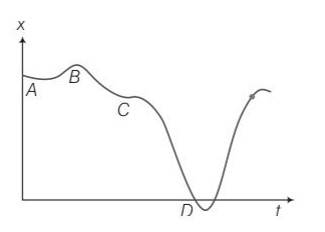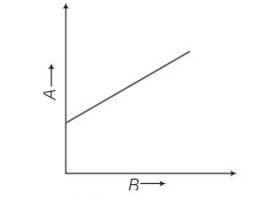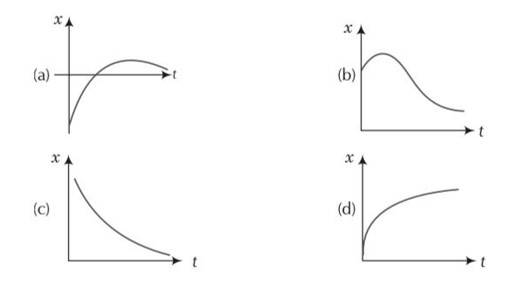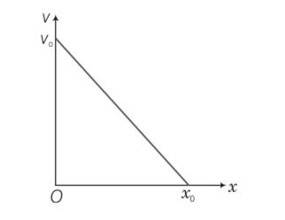Motion in a Straight Line
Get insights from 82 questions on Motion in a Straight Line, answered by students, alumni, and experts. You may also ask and answer any question you like about Motion in a Straight Line
Follow Ask QuestionQuestions
Discussions
Active Users
Followers
New answer posted
5 months agoContributor-Level 10
This is a multiple choice answer as classified in NCERT Exemplar
(a, c, d) at point A graph will parallel to time axis hence, v=dx/dt=0. As the starting point is A hence, we can say that the particle is starting from rest.
At C, the graph changes slope, hence velocity also changes. As graph at C is almost parallel to time axis hence, we can say that velocity vanishes.
Velocity is 0. So particle at rest that time. As slope of D will be greater than E . so velocity will be greater at D.
New answer posted
5 months agoContributor-Level 10
This is a multiple choice answer as classified in NCERT Exemplar
(a, c, d) when we are calculating velocity of a displacement time graph we have to take slope similarly we have to take slope of velocity time graph to calculate acceleration . when slope is constant motion will be uniform.
When we are representing motion by a graph it may be displacement time, velocity time or acceleration time. Hence B may represent time . for uniform motion velocity time graph should be a straight line parallel to time axis.
if Quantity B may represent time. Also Quantity A is displacement if motion is uniform. Quantity A is velocity if motion is uniform
New answer posted
5 months agoContributor-Level 10
This is a multiple choice answer as classified in NCERT Exemplar
(c) in this situation we have to find net velocity with respect to the earth that will be equal to velocity of the girl plus velocity of escalator.
Let displacement is L the
Velocity of girl vg= L/t1
Velocity of escalator ve= L/t2
net velocity = velocity of escalator +velocity of girl
Vg=l/t1 and Ve=l/t2
So net velocity = L/t1+ L/t2
So t=
New answer posted
5 months agoContributor-Level 10
This is a multiple choice answer as classified in NCERT Exemplar
(b) x = (t-2)2
V= dx/dt= 2 (t-2)
And acceleration a = 2
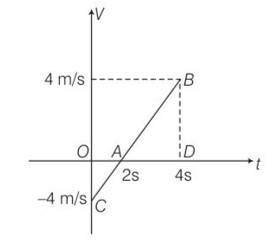
When t =0 v= -4m/s
When t= 2s v= 0m/s
When t= 4s v= 4m/s
Distance travelled = area of graph =area of OAC+area of ABD= =8m
New answer posted
5 months agoContributor-Level 10
This is a multiple choice answer as classified in NCERT Exemplar
(c) Time taken to travel first half distance t1=
Time taken to travel second half distance t2=
Total time =t1+t2
formula for average velocity will be =
formula for average velocity will be= vav=average speed= total distance/total time =
New answer posted
5 months agoContributor-Level 10
This is a multiple choice answer as classified in NCERT Exemplar
(b) For maximum and minimum displacement we have to keep in mind the magnitude and direction of maximum velocity.
As maximum velocity in positive direction is vo maximum velocity in opposite direction is also vo.
Maximum displacement in one direction = voT
Maximum displacement in opposite direction=-voT
Hence -voT
New answer posted
5 months agoContributor-Level 10
This is a multiple choice answer as classified in NCERT Exemplar
(a) As the lift when coming downward directions displacement will be negative. We have to see whether the motion is accelerating or retarding.
We know that due to downward motion displacement will be negative, when the lift reaches 4th floor is about to stop hence motion is retarding in nature.
As displacement is in negative direction . velocity will also be negative i.e v<0
New answer posted
5 months agoContributor-Level 10
This is a multiple choice answer as classified in NCERT Exemplar
(b) To making it vanish one part must cancel other part which is only possible in graph b.
As there are opposite velocities in the interval 0 to T hence average velocity can vanish in b .
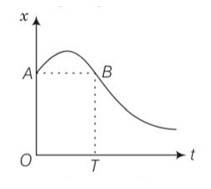
New answer posted
5 months agoContributor-Level 10
This is a short answer type question as classified in NCERT Exemplar
let initial velocity Vi
Distance travelled in time t= xi
For the graph
tan = vi/xi= vi-v/x
V= -vix/xi+Vo
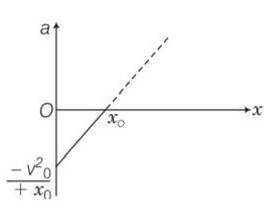
Acceleration, a = dv/dx= -vidx/xidt
So a= -viv/xi=
New answer posted
5 months agoContributor-Level 10
This is a short answer type question as classified in NCERT Exemplar
When the ball dropped from the building u1=0, u2=40m/s
Velocity of the dropped ball after time t
V1=u1+gt
V1 = gt
For ball thrown up u2=40m/s
Velocity of the ball after time t
V2=u2-gt
=40-gt
Relative velocity =v1-v2
=gt- [-40-gt]=40m/s
Taking an Exam? Selecting a College?
Get authentic answers from experts, students and alumni that you won't find anywhere else
Sign Up on ShikshaOn Shiksha, get access to
- 66k Colleges
- 1.2k Exams
- 680k Reviews
- 1800k Answers

